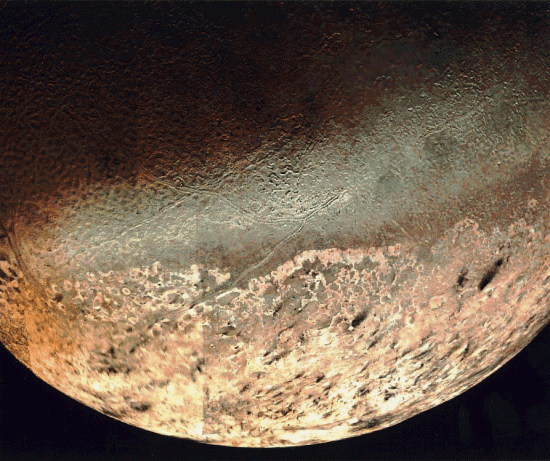May 24, 2013
Triton is one of the most mysterious objects in the solar system, with plumes of nitrogen spewing from frozen “geysers” near its south pole.
Of Neptune’s thirteen satellites, all but one are irregular in shape and mostly rock and ice. Triton is farthest out and is much larger than the others, with a diameter of 2700 kilometers, making it a planet-sized object. Triton rotates in a clockwise, circular direction (looking down from its north pole), with an axial tilt of 157 degrees. Neptune and its other complement of moons all rotate in a counterclockwise direction. Summertime temperature on Triton is a balmy 38 Kelvin, or just above absolute zero.
On August 20, 1977, NASA launched the Voyager 2 mission on a multiyear journey to the outer Solar System. Twelve years after launch, on August 25, 1989, Voyager 2 was the first spacecraft to return close up images of Neptune, the most distant planet from the Sun. Since NASA has “downgraded” Pluto to a Kuiper Belt Object, similar to Eris and Sedna, Neptune is now the eighth, and last, “official” planet.
While Neptune provided stunning images and a wealth of scientific data that will keep astrophysicists busy for years, the most interesting and controversial aspect of the mission was the discovery of huge, cryogenic “ice volcanoes” on Triton. Several types of this structure were found in the southern region of the moon. The geysers leave behind “wind streaks” and fan-shaped, dark deposits near the point of eruption and are presumed to be liquid nitrogen mixed with frozen methane, as well as organic materials. The energy source for these eruptive features is unknown, but the conventional reason is that the Sun is providing the heat. JPL scientists write:
“Trapping of solar radiation in a translucent, low-conductivity surface layer (in a solid-state greenhouse), which is subsequently released in the form of latent heat of sublimation, could provide the required energy. Both the classical solid-state greenhouse consisting of exponentially absorbed insolation in a gray, translucent layer of solid nitrogen, and the ‘super’ greenhouse consisting of a relatively transparent solid-nitrogen layer over an opaque, absorbing layer are plausible candidates.”
“Insolation”, or exposure to the Sun’s rays, is an unsatisfactory explanation for these features. Since the Sun is approximately 4496.7 million kilometers from Triton, the overall solar radiation that impacts its surface must be incredibly weak. The effect of electromagnetism is inversely proportional to distance, so the amount of energy received by Triton falls off with the square of the distance. That means Triton receives about 10^-3 times less solar radiation than Earth, a mere 1.5 watts per meter.
In a previous Picture of the Day, an examination of the arachnoid features and “dalmatian spots” on Mars associates them with electric discharges. The features on Mars are indicative of “particle beams” impacting the extremely cold, carbon dioxide frost and subliming it to gas. As was noted:
“If the dark spotting on Mars’ south polar ice is indeed caused by charged particle streams, one of the first things we should look for is an active response of the surface to these events. Since the dark spotting is occurring in the Martian south polar spring, that would be the time to look for signs of energetic activity–not unlike the so-called “volcanic” plumes of Jupiter’s closest moon Io, or the “geysers” of Saturn’s moon Enceladus.”
To this may now be added the dark spotting, wind streaks and geysers on Triton.
Stephen Smith













